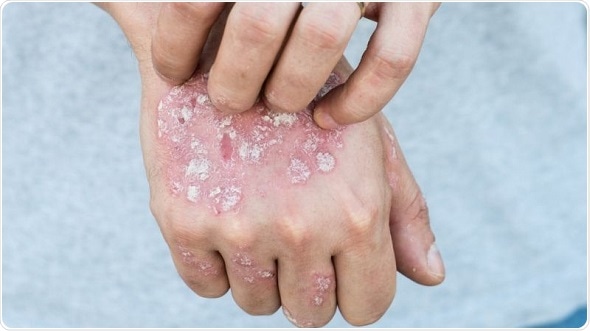Johns Hopkins researchers report that prurigo nodularis (PN), a skin disease characterized by severely itchy, firm bumps on the skin, may be associated with other inflammatory skin disorders as well as systemic and mental health disorders. Compared with other skin diseases, however, not much is known about PN. While symptoms of PN can be managed, no cures exist. Researchers were looking to determine associated conditions that are more common in patients with PN, compared with similar patients without PN.

Credit: Getty Images
A report on the findings was published in the Journal of Investigative Dermatology.
A lot of patients who have prurigo nodularis also have associated severe health conditions that need more immediate attention, and many of these PN patients may fall through the cracks.”
Dermatologist Shawn Kwatra, M.D., assistant professor of dermatology at the Johns Hopkins University School of Medicine
While skin conditions such as psoriasis and eczema are known to be caused by an overactive immune system, the underlying molecular cause of PN remains unknown because the disease has been understudied. Kwatra and colleagues then sought to learn more by first estimating how prevalent PN is in the United States.
As a starting point, Kwatra and team analyzed one of the largest national databases of insurance data in the U.S. (IBM MarketScan Commercial Claims and Encounters) between October 2015 and December 2016. They identified patients 18–64 years old with medical insurance who presented two or more insurance claims relating to PN, maintained for three months or more, and compared them with patients without PN, patients with atopic dermatitis and patients with psoriasis.
In their study, they identified 7,095 people with PN, 23,882 with atopic dermatitis without PN and 38,283 with psoriasis without PN. Based on these numbers, they calculated that more than 72 per 100,000 people are affected with PN, primarily females with an average age of 50 years.
“The real numbers may be higher than this because our data only included people with health insurance and between the ages of 18 and 64,” says Johns Hopkins University School of Medicine fourth-year medical student Amy Huang.
According to The National Institutes of Health, PN may develop from other skin diseases or other health issues that may be common in families, and even environmental factors may place one at an increased risk of developing PN. Analyzing the data further, the team found that those with PN have increased risk of other conditions compared with people without PN, including HIV, kidney disease, non-Hodgkin’s lymphoma and mental health disorders.
“We are eager to better understand PN because that will help in the management of our patients,” says Kwatra. “Our goal is to inform other physicians about the frequency of PN-related associated conditions to guide an evidence-based, targeted diagnostic workup. Enhanced disease recognition and ongoing translational studies will provide further clues to the development of PN.”
While there is no cure for PN, current treatment includes phototherapy, topical steroids and off-label management with immune suppressants and anticonvulsants. Kwatra says it’s important for physicians to be well-informed about related conditions so PN can be properly diagnosed and managed.
Ongoing research initiatives include examining the patterns of PN in children and adults age 65 and over and how PN treatment affects these populations. Additional studies are ongoing by Kwatra’s group to understand the molecular explanation of PN.
Further research is needed to clarify how chronic conditions such as atopic dermatitis, HIV, renal impairment and mental health conditions may contribute to the development of PN.
“With such a large population of people who have this neglected disease, we’ve only scratched the surface and are happy to take the lead with investigating this understudied condition,” Kwatra says.
Source:
Journal reference:
Huang, A.H. et al. (2019) Real-world prevalence of prurigo nodularis and burden of associated diseases. Journal of Investigative Dermatology. doi.org/10.1016/j.jid.2019.07.697.